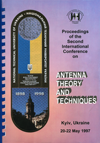Methods of perfecting the features of adaptive antennas and algorithms of high resolution processing
DOI:
https://doi.org/10.1109/ICATT.1997.1235179Abstract
All known adaptive processing methods, having a number of merits, at the same time don't allow to realize the effective processing in the case when a number of the input signals exceeds a number of the array hydrophones [1, 2]. So the noise own vectors determine with error and no one of the adaptive algorithms give the real signal bearings. To solve a problem by increasing of the array hydrophones isn't expedient because of the enormous increasing of the computing expenditures for the matrix treatment. Therefore, a search of the ways of the input matrix rank reduction has a practical interest. It will allow to use a known method of the algebraic structures having such merits as high resolution, invariance to the input SNR [3, 4].References
Ligget, W.S. NATO ASI on Signal Processing, Loughborough, UK, 1972.
Capon, J.; et al. Proc. IEEE, 55, 1967, p. 192-211.
Bienvenu, G.; Kopp, L. Colloque GRETSI, Nice, May 1979, p. 106-110.
Bienvenu, G.; Kopp, L. Proceedings ICASSP, 80, p. 307-310.
Widrow, B.; et al. Adaptive antenna systems. Proc. IEEE, Dec. 1967, 55, p. 2143-2158.
Widrow, B.; et al. Adaptive Noise Cancelling: Principles and Applications. Proc. IEEE, Dec. 1975, 63, p. 1692-1716.
Published
1997-05-24
Issue
Section
Remote sensing and hydroacoustic antennas

